|
The Mastikachoria
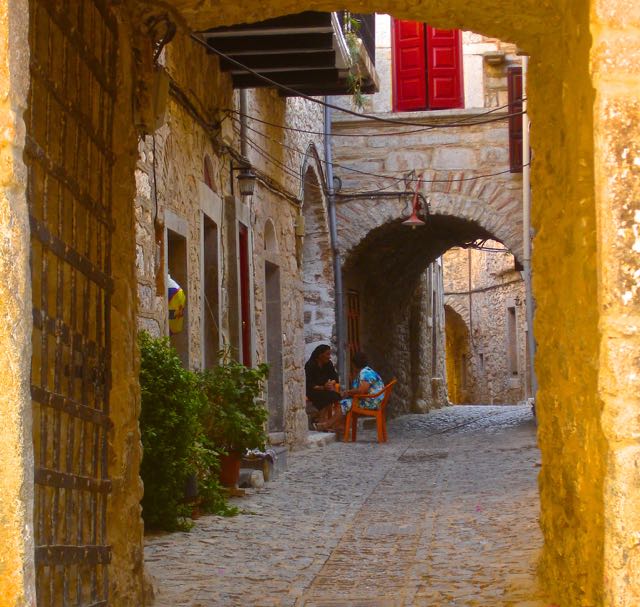 The best part of Chios and what makes the island unique is what are known as the mastikahoria, the famous mastic villages of Chios. These are a series of fortified villages built in the 14th century during Genovese rule (1346-1566). These villages had an economy based on the cultivation of masticha, a gum
like sap from the mastic trees
that
are unique to the island and were so prized that the Genovese built fortresses to protect them, and when the Turks massacred the inhabitants of Chios, the mastic villages were spared. Of these villages the most impressive are Pirgi with its intricately painted houses, Olympi and Mesta which are both medieval fortress towns pretty much intact. These villages were built out of sight from the sea and surrounded by high walls with a central tower that was the last resort in case the walls
were breached
by the Arabic pirates who raided the coasts of the Mediterranean. The tower had no door at street level but was entered by ladders which were used as bridges from the rooftops and then pulled up. The tower had three floors and in the case of Mesta an underground tunnel that led to the well so that even in a siege water would be available. The best part of Chios and what makes the island unique is what are known as the mastikahoria, the famous mastic villages of Chios. These are a series of fortified villages built in the 14th century during Genovese rule (1346-1566). These villages had an economy based on the cultivation of masticha, a gum
like sap from the mastic trees
that
are unique to the island and were so prized that the Genovese built fortresses to protect them, and when the Turks massacred the inhabitants of Chios, the mastic villages were spared. Of these villages the most impressive are Pirgi with its intricately painted houses, Olympi and Mesta which are both medieval fortress towns pretty much intact. These villages were built out of sight from the sea and surrounded by high walls with a central tower that was the last resort in case the walls
were breached
by the Arabic pirates who raided the coasts of the Mediterranean. The tower had no door at street level but was entered by ladders which were used as bridges from the rooftops and then pulled up. The tower had three floors and in the case of Mesta an underground tunnel that led to the well so that even in a siege water would be available.
|
|
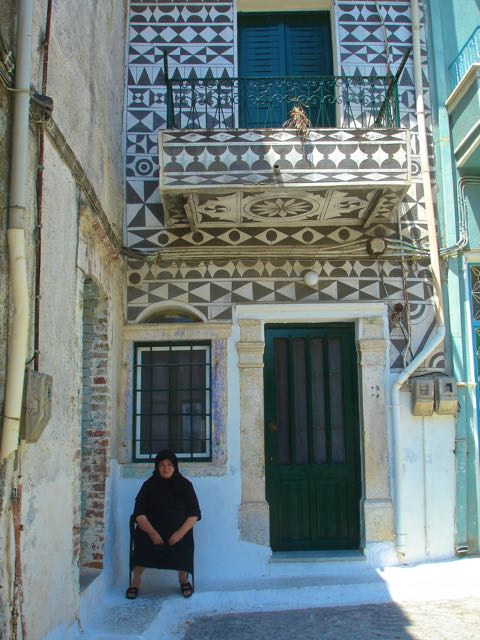 The streets were also designed for defensive purposes, narrow and dark with blind alleys that would not only confuse the invaders but enable the villagers to
attack them from above using the
walkways and arches that connected the buildings. The houses themselves were small individual fortresses and were an essential part of the whole castle and defensive system. The ground floor has one entrance and no windows. The animals lived downstairs. The main characteristic of the house is the pounti, a sort of patio on the first floor reached by a staircase which led to the sleeping areas, usually two bedrooms. The pounti had a ladder that went to the roof. In the case of an invasion the
ladder
could be pulled
up and the villagers could walk to the central tower for protection. The roofs of the village were also used for drying almonds or for sleeping out on hot summer nights. These fortress towns were based on the designs of the ancient Greek towns of Ionia. The streets were also designed for defensive purposes, narrow and dark with blind alleys that would not only confuse the invaders but enable the villagers to
attack them from above using the
walkways and arches that connected the buildings. The houses themselves were small individual fortresses and were an essential part of the whole castle and defensive system. The ground floor has one entrance and no windows. The animals lived downstairs. The main characteristic of the house is the pounti, a sort of patio on the first floor reached by a staircase which led to the sleeping areas, usually two bedrooms. The pounti had a ladder that went to the roof. In the case of an invasion the
ladder
could be pulled
up and the villagers could walk to the central tower for protection. The roofs of the village were also used for drying almonds or for sleeping out on hot summer nights. These fortress towns were based on the designs of the ancient Greek towns of Ionia.
Pirgi is the largest of these mastic villages. Its outer wall is mostly gone enabling the village to creep out beyond its former boundaries. Like the other fortified villages there was a central tower. In Pirgi the tower still exists and sections of it have been turned into residences. Above the main square is the church of Kimissis Tis Theotokou (Our Lady's Dormition),
a three-aisle basilica built in 1694. Just off the main square down a small covered alleyway is the 13th Century church of Agios Apostoli with its frescoes, painted by Domestihos Kinigos of Crete. This church is one of the oldest and most visited on the island. It is a copy of Nea Moni, the famous monastery in Chios. There are two other
churches in the village worth visiting, Taxiarchis, which was built in 1680 and Ipapanti which is even older. The main square has a
beautiful old cafeneon run by an old Greek-American from Astoria who serves an excellent mezedes with his ouzo.
|
|
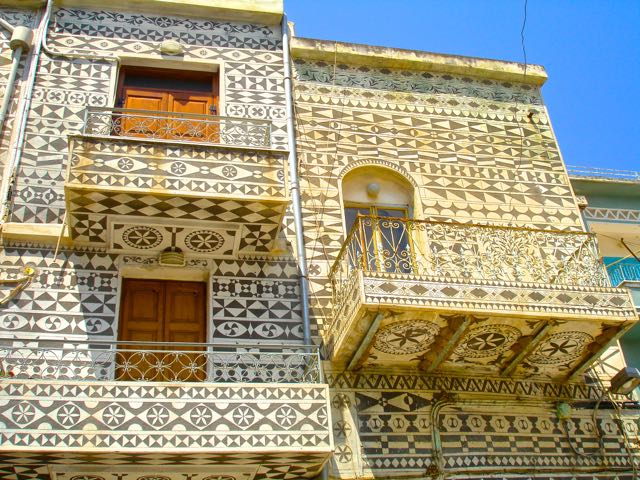 The most interesting feature of Pirgi are the decorative designs scratched into the exterior walls of the houses, known as ksista. Mostly geometric forms, ksista has gone through several periods and may have originated in Genoa or in Constantinople. The process, which is still practiced today, even
on the modern
buildings of the village, begins with the spreading of a mixture of sand, asbestos and cement on the walls of the house. This is then covered
with white asvestis (No, not the poisonous asbestos, in Greece asvestis means lime. If you want to say asbestos it is amiantos). When it dries the patterns are drawn onto the outer layer and then scratched with a fork to reveal the darker layers beneath. The whole village is covered in these designs, including some of the churches and the local bank. Another feature of the village are the tomatoes which hang drying beneath many of the balconies of Pirgi, adding a splash of color
to the back and white designs on the houses. The most interesting feature of Pirgi are the decorative designs scratched into the exterior walls of the houses, known as ksista. Mostly geometric forms, ksista has gone through several periods and may have originated in Genoa or in Constantinople. The process, which is still practiced today, even
on the modern
buildings of the village, begins with the spreading of a mixture of sand, asbestos and cement on the walls of the house. This is then covered
with white asvestis (No, not the poisonous asbestos, in Greece asvestis means lime. If you want to say asbestos it is amiantos). When it dries the patterns are drawn onto the outer layer and then scratched with a fork to reveal the darker layers beneath. The whole village is covered in these designs, including some of the churches and the local bank. Another feature of the village are the tomatoes which hang drying beneath many of the balconies of Pirgi, adding a splash of color
to the back and white designs on the houses.
|
|
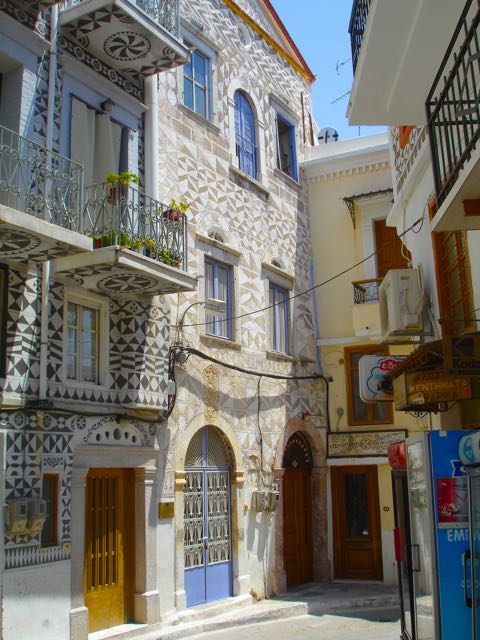 Pirgi is the ancestral home of Christopher Columbus, according to the locals, and what is said to be his house (photo), just off the main square, had a plaque placed there by the European Union, that since my visit has been removed for whatever reason, maybe due to complaints by Italians.
It is accepted that he lived here for a time. But was Columbus from Chios as many people from Chios
and even a few scholars
believe? This seems a likely possibility. If you were Queen Isabella who would you be more willing to trust to find a route to the east and give three ships and the equivalent of a few million dollars to? The peasant son of a wool-worker from Genoa, or a Byzantine seaman (or prince as some people believe) from the island of Chios?
There are still many people in Pirgi whose last name is indeed Columbus or Couloumbos. It is known that many of his crew were Greeks, many of his friends as well and that the notes he wrote in the margins of his books were also in Greek. Furthermore he wrote about the island of Chios and the healing properties of mastic. The people of Genoa may not like the idea that Columbus came from Chios since they have made a fortune off him in tourism but if you look at the evidence you have to admit that Chios should be
at least considered as
the new Mecca for Columbofiles, if there is such a thing anymore. Columbus has dropped in popularity since the days when I was in elementary school and Columbus Day was a holiday. In fact many people hate him now because of the atrocities he committed against the native Americans. But that is all besides the point when the question is was he from Chios or Genoa, since being from one place or the other would not change anything. Personally I don't care but there are people who do and have written
books about it and even have a society dedicated to this theory which you can read about here: Click for more about Columbus and Chios Pirgi is the ancestral home of Christopher Columbus, according to the locals, and what is said to be his house (photo), just off the main square, had a plaque placed there by the European Union, that since my visit has been removed for whatever reason, maybe due to complaints by Italians.
It is accepted that he lived here for a time. But was Columbus from Chios as many people from Chios
and even a few scholars
believe? This seems a likely possibility. If you were Queen Isabella who would you be more willing to trust to find a route to the east and give three ships and the equivalent of a few million dollars to? The peasant son of a wool-worker from Genoa, or a Byzantine seaman (or prince as some people believe) from the island of Chios?
There are still many people in Pirgi whose last name is indeed Columbus or Couloumbos. It is known that many of his crew were Greeks, many of his friends as well and that the notes he wrote in the margins of his books were also in Greek. Furthermore he wrote about the island of Chios and the healing properties of mastic. The people of Genoa may not like the idea that Columbus came from Chios since they have made a fortune off him in tourism but if you look at the evidence you have to admit that Chios should be
at least considered as
the new Mecca for Columbofiles, if there is such a thing anymore. Columbus has dropped in popularity since the days when I was in elementary school and Columbus Day was a holiday. In fact many people hate him now because of the atrocities he committed against the native Americans. But that is all besides the point when the question is was he from Chios or Genoa, since being from one place or the other would not change anything. Personally I don't care but there are people who do and have written
books about it and even have a society dedicated to this theory which you can read about here: Click for more about Columbus and Chios
|
|
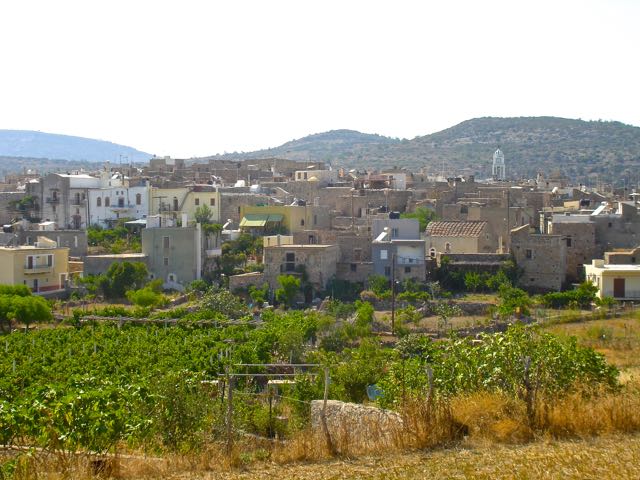 Just down the road from Pirgi is Olympi one of the most impressive of the mastikahoria. The outer wall of this village is still intact though windows and doors have been cut into them. There is a beautiful little square and a couple of cafeneon-restaurants and the church of Agia Paraskevis. The central tower is still standing
though in ruins.
A few kilometers down the road is the Cave of Olympi, with the largest number of stalagmites and stalactites per square meter of any cave in the Balkans. The cave was
discovered in the hole where the villagers used to throw their dead animals and is still being explored. You can do a twenty minute tour which goes every hour or so from 11:00 to 18:00 every day except Monday. You may notice some interesting billboards on the road between Olympi and the caves and you may be curious as to what they are all about. What they basically say is that if you see something metallic don't pick it up. The area was used in the past for military target practice and there may be unexploded
shells around.
So rather than wander in the hills and risk getting blown up take the road to the small beach at Fani and on the way stop at the ruins of the Sanctuary of Apollo Phaneos and the small church built on its foundation. Just down the road from Pirgi is Olympi one of the most impressive of the mastikahoria. The outer wall of this village is still intact though windows and doors have been cut into them. There is a beautiful little square and a couple of cafeneon-restaurants and the church of Agia Paraskevis. The central tower is still standing
though in ruins.
A few kilometers down the road is the Cave of Olympi, with the largest number of stalagmites and stalactites per square meter of any cave in the Balkans. The cave was
discovered in the hole where the villagers used to throw their dead animals and is still being explored. You can do a twenty minute tour which goes every hour or so from 11:00 to 18:00 every day except Monday. You may notice some interesting billboards on the road between Olympi and the caves and you may be curious as to what they are all about. What they basically say is that if you see something metallic don't pick it up. The area was used in the past for military target practice and there may be unexploded
shells around.
So rather than wander in the hills and risk getting blown up take the road to the small beach at Fani and on the way stop at the ruins of the Sanctuary of Apollo Phaneos and the small church built on its foundation.
|
|
Mesta
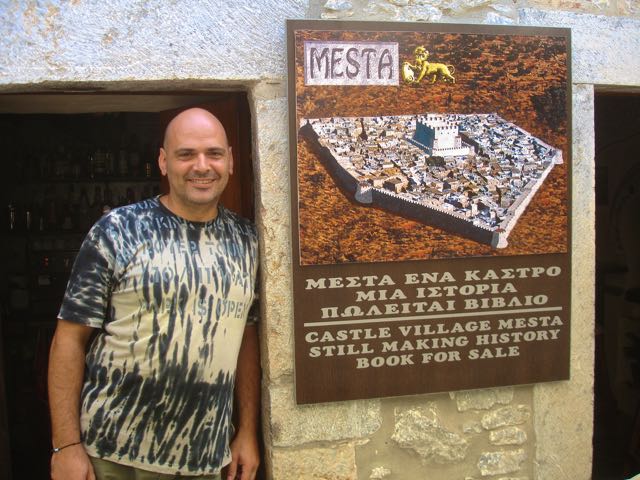 My favorite town in Chios is Mesta, a completely intact fortress town of 300 people, the best preserved of the mastic villages, a living history and cultural museum where life goes on the way it has for hundreds of years. In the Turkish genocide of 1922 many of the inhabitants were captured to be used
as slaves. Because mastic was so
important a product, those
who knew how to grow and process it were freed and sent back to the village. In 1858 the defensive tower
which was no longer considered necessary was demolished to build the Church of the Taxiarchis, still the largest church in Chios. It overlooks the main square which has two cafes and the very good taverna O Meseonas, owned by the lovely Despina Bournia, who along with Anna Floradi is very active in promoting the village. The restaurant has a varied menu that features many local Chios dishes such as their tomato keftedes, local cheese and my favorite discovery of the
trip, souma,
a drink made from figs that is similar in taste and potency to raki or tsipuro. (Or moonshine if you are from the southern United States). My favorite town in Chios is Mesta, a completely intact fortress town of 300 people, the best preserved of the mastic villages, a living history and cultural museum where life goes on the way it has for hundreds of years. In the Turkish genocide of 1922 many of the inhabitants were captured to be used
as slaves. Because mastic was so
important a product, those
who knew how to grow and process it were freed and sent back to the village. In 1858 the defensive tower
which was no longer considered necessary was demolished to build the Church of the Taxiarchis, still the largest church in Chios. It overlooks the main square which has two cafes and the very good taverna O Meseonas, owned by the lovely Despina Bournia, who along with Anna Floradi is very active in promoting the village. The restaurant has a varied menu that features many local Chios dishes such as their tomato keftedes, local cheese and my favorite discovery of the
trip, souma,
a drink made from figs that is similar in taste and potency to raki or tsipuro. (Or moonshine if you are from the southern United States).
|
|
Besides
Despina's taverna in the main square there several cafes and there are two or three psistaria-pizza places outside the village walls. The older church of the Taxiarchis from the 4th ort 5th century contains a number of frescoes and wood carvings of scenes from the Old Testament and the life of Jesus. This church was actually a monastery and the village grew up outside its walls, eventually enclosing itself in the outer walls.
|
|
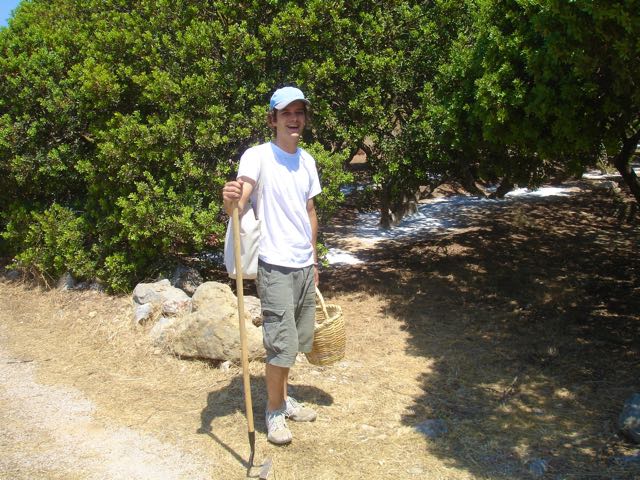 Two people leading the way in Chios eco-tourism are Vassilis Ballas and Roula Boura who left their desk jobs in Athens to come to Chios to create their vision which they called Chios Masticulture, teaching Greeks
and tourists about the cultivation and production of mastic as well as other traditional activities. Vassilis took us out to the mastic orchards outside the village and showed us the whole process of extracting and collecting the mastic.
Additional activities they provide in their tours
include creating a garden of organically grown local vegetables, visiting local
wineries and other agricultural processing plants and bee hives, joining local
fishermen in fishing expeditions, and hiking around the countryside where,
depending on the season, they pick mushrooms and local herbs. They also help with room bookings, ferry tickets, and car rentals, organize conferences, business meetings, and other events for professional
organizations and businesses, in indoor and/or outdoor village locations
appropriate for group events. Most importantly they educate visitors on the cultivation and production of mastika. Masticulture puts together ecotourism packages that combine hospitality and outdoor activities related to all the things that compose the culture of Chios: its customs and traditions, popular arts and crafts,
agricultural labour and produce, architecture, and much more. For more information see the Chios Masticulture website. Two people leading the way in Chios eco-tourism are Vassilis Ballas and Roula Boura who left their desk jobs in Athens to come to Chios to create their vision which they called Chios Masticulture, teaching Greeks
and tourists about the cultivation and production of mastic as well as other traditional activities. Vassilis took us out to the mastic orchards outside the village and showed us the whole process of extracting and collecting the mastic.
Additional activities they provide in their tours
include creating a garden of organically grown local vegetables, visiting local
wineries and other agricultural processing plants and bee hives, joining local
fishermen in fishing expeditions, and hiking around the countryside where,
depending on the season, they pick mushrooms and local herbs. They also help with room bookings, ferry tickets, and car rentals, organize conferences, business meetings, and other events for professional
organizations and businesses, in indoor and/or outdoor village locations
appropriate for group events. Most importantly they educate visitors on the cultivation and production of mastika. Masticulture puts together ecotourism packages that combine hospitality and outdoor activities related to all the things that compose the culture of Chios: its customs and traditions, popular arts and crafts,
agricultural labour and produce, architecture, and much more. For more information see the Chios Masticulture website.
|
|
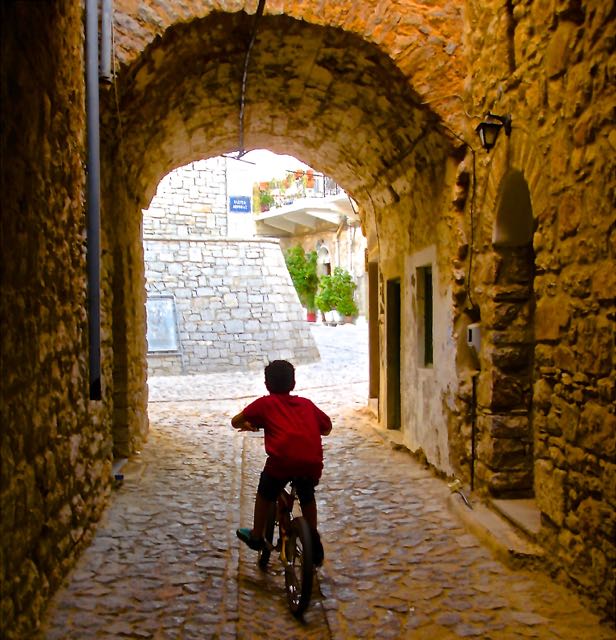 Mesta is one of those perfect villages for families. There are several gates into the town, none wide enough for a car so kids are safe to play in the streets. We stayed in the Anna Floradi Apartments,
which are traditional rooms in one of the medieval dwellings. We also were
given a tour of the Medieval Castle Suites, a collection of houses scattered around the village that have been renovated into luxury apartments with air-conditioning, full kitchens, stereos, Internet and satellite television. There are numerous trails to hike including many that lead to the beaches and the path between Mesta
and Olympoi that goes past the church of Ag Antonios as well as the old aqueduct and stone wells. With the cultural and educational activities provided by Masticulture and the Cultural Association of Mesta there is no reason why you or your family should worry about there not being enough to do here. But just in case let me add that Mesta is also known for the large number of religious and cultural celebrations throughout the year. Mesta is one of those perfect villages for families. There are several gates into the town, none wide enough for a car so kids are safe to play in the streets. We stayed in the Anna Floradi Apartments,
which are traditional rooms in one of the medieval dwellings. We also were
given a tour of the Medieval Castle Suites, a collection of houses scattered around the village that have been renovated into luxury apartments with air-conditioning, full kitchens, stereos, Internet and satellite television. There are numerous trails to hike including many that lead to the beaches and the path between Mesta
and Olympoi that goes past the church of Ag Antonios as well as the old aqueduct and stone wells. With the cultural and educational activities provided by Masticulture and the Cultural Association of Mesta there is no reason why you or your family should worry about there not being enough to do here. But just in case let me add that Mesta is also known for the large number of religious and cultural celebrations throughout the year.
Apokreas (carnival) is a fun time to be in Mesta with parties in the village and the main square. On Clean Monday they have a popular court of justice in the square. Based on a tradition that dates back to the occupation when the Turkish Pasha enforced his own laws with harsh penalties, the trials satirize this period with crazy accusations of 'crimes' that villagers have supposedly committed
which they
then have to stand trial for while standing before an older member
of the village dressed as the Pasha who metes out punishments based on the accused's financial status. People come from all over Chios for these trials.
|
|
"At the Carnival, in Mesta and some other of the island's villages revives
the custom of "Agas". Its roots go back to the period where the Aga (the
ottoman tax collector) would visit the village to collect the taxes in
mastic. Nowadays the event is a humorous and recreational festival that
coincides with the closing of the carnival. The celebration starts with a
parade from the old school outside of the village to the central square. At
the Village's Gate a small battle is being performed as the Agas and his
crew riding donkeys are trying to invade the village. They arrive in the
central square accompanied by locals dressed in traditional costumes playing
music instruments and singing old songs and "amanedes". During the trial
Agas who is a very strict judge judges and condemns the most of the people
that are present. More over, they are obligated to buy off their sentence,
otherwise the Agas orders his officers to beat them up. The sessions are
interrupted by music and dances by the folk dance group of the village or
the locals and the visitors.
The event is hosted by the cultural association of the village.
It is one of the oldest and most interesting custom of Chios Island and is
revived in Mesta and other villages. The first time we had this event was
around 1830 to 1840." Vassilis Ballas
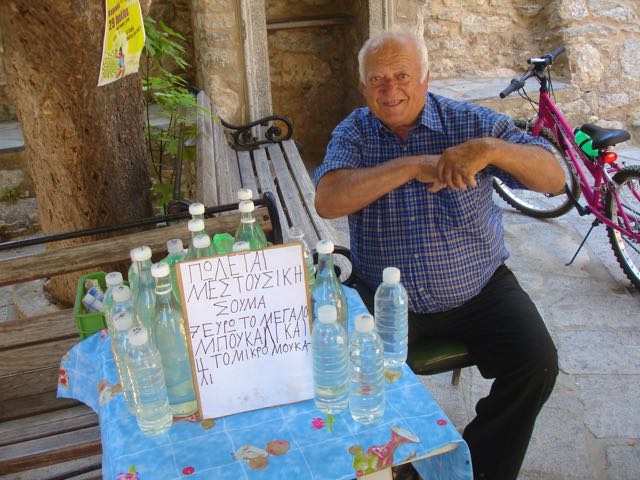 During Easter there is a big fire in the square and an effigy of Judas is burned. (They used to hang him from a tree outside the village and shoot at him). There are also a number of feasts on the saints days of the village churches including August 1st when everyone goes to the small island of St Stefanos and celebrates til dawn. On August
8th the celebration of St Aimilianos takes place on the beach of Merikounda and again lasts through the night. On the 11th of
August the town of Mesta
hosts the Festival of Souma, the above-mentioned alcoholic drink made from figs. A giant distiller is set up in the square and people drink the souma and dance all night long. On August 17th is the Festival of the Fishermen with a fishing contest in the morning and fish soup at night. On November 8th people come from all over Chios for the saint day of the Great Taxiarchis and on the 11th the whole island is celebrating its liberation in 1912 when Chios officially became part of Greece. During Easter there is a big fire in the square and an effigy of Judas is burned. (They used to hang him from a tree outside the village and shoot at him). There are also a number of feasts on the saints days of the village churches including August 1st when everyone goes to the small island of St Stefanos and celebrates til dawn. On August
8th the celebration of St Aimilianos takes place on the beach of Merikounda and again lasts through the night. On the 11th of
August the town of Mesta
hosts the Festival of Souma, the above-mentioned alcoholic drink made from figs. A giant distiller is set up in the square and people drink the souma and dance all night long. On August 17th is the Festival of the Fishermen with a fishing contest in the morning and fish soup at night. On November 8th people come from all over Chios for the saint day of the Great Taxiarchis and on the 11th the whole island is celebrating its liberation in 1912 when Chios officially became part of Greece.
|
|
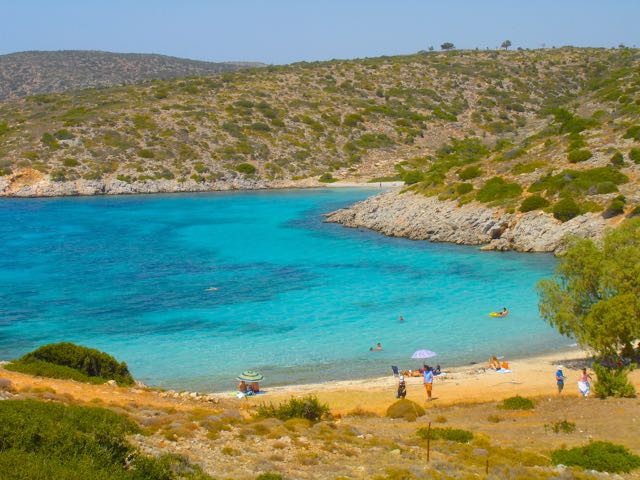 There are a half dozen or so beaches within twenty minutes drive from Mesta which range from beautiful to spectacular. Because some of the beaches are protected from the north winds and others from the south, you can always find a beach to enjoy regardless of the weather conditions. At Agia Dynami (photo) you will find some of the most beautiful
turquoise water you will
see anywhere in Greece and Agia Theodocia monastery which has a covered picnic area where people escape
the sun and eat their lunch. Trahilia is a narrow peninsula with a beach on either side that leads to a rocky island that is terrific for snorkeling. There are a handful of fishing boats that are based here. You can reach these beaches by footpath or on the paved (and unpaved) roads that wind through the olive and mastika groves. Other beaches worth spending the day include Avlonia, Apothika, Merikounta, and Potami. There are a half dozen or so beaches within twenty minutes drive from Mesta which range from beautiful to spectacular. Because some of the beaches are protected from the north winds and others from the south, you can always find a beach to enjoy regardless of the weather conditions. At Agia Dynami (photo) you will find some of the most beautiful
turquoise water you will
see anywhere in Greece and Agia Theodocia monastery which has a covered picnic area where people escape
the sun and eat their lunch. Trahilia is a narrow peninsula with a beach on either side that leads to a rocky island that is terrific for snorkeling. There are a handful of fishing boats that are based here. You can reach these beaches by footpath or on the paved (and unpaved) roads that wind through the olive and mastika groves. Other beaches worth spending the day include Avlonia, Apothika, Merikounta, and Potami.
|
|
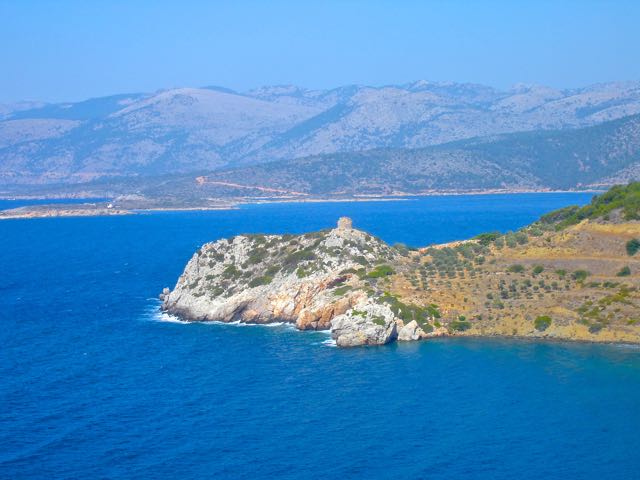 The coast is dotted with a series of Genovese watchtowers known as vigles which warned the people of Chios of any impending attacks by pirates. These towers were around 15 meters high with the entrance on the second floor. The Vigla at the port of Mesta is one of the most intact and can be reached on foot
from Mesta through the pine
forest. These vigles were within sight of each other so by going to one you can look up and down the coast and see them in series. Another
mostly intact tower is the one at Didima just 2 kilometers north of Limenas, the port of Mesta. The port itself is in transition, having received money from the EU to make it able to handle larger boats since it is closer to the mainland and the Cyclades islands than the port of Chios town which faces Turkey. Limenas has a small tree shaded beach and some rooms to rent as well as the popular fish taverna O Sergis. The coast is dotted with a series of Genovese watchtowers known as vigles which warned the people of Chios of any impending attacks by pirates. These towers were around 15 meters high with the entrance on the second floor. The Vigla at the port of Mesta is one of the most intact and can be reached on foot
from Mesta through the pine
forest. These vigles were within sight of each other so by going to one you can look up and down the coast and see them in series. Another
mostly intact tower is the one at Didima just 2 kilometers north of Limenas, the port of Mesta. The port itself is in transition, having received money from the EU to make it able to handle larger boats since it is closer to the mainland and the Cyclades islands than the port of Chios town which faces Turkey. Limenas has a small tree shaded beach and some rooms to rent as well as the popular fish taverna O Sergis.
|
|
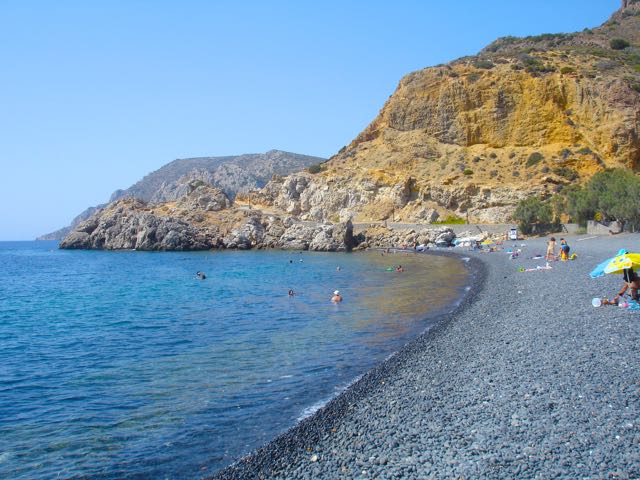 If you have a week to spend in Chios my advice would be to base yourself in Mesta for at least 3 of those days and use the town to explore southern Chios. Otherwise go to Emborio near the southeast tip of the island. The town is believed to be the ancient Leukonion mentioned by Thucidides and
excavations have unearthed a temple to Athena
and other buildings including a sanctuary to the Goddess near the harbor below. Over fifty houses have been excavated and as work continues they expect to uncover more.
The extinct volcano of Psaronas rises next to the modern village and is the cause of the black pebble beaches of Mavros Gialos and Foki which are similar to the famous black sand beaches of Santorini. They are among the most spectacular beaches in all the Greek islands and on summer weekends draw a crowd so either get out of town by then or use Sunday to explore the rest of the island and return to your hotel on Sunday evening when all the kids have gone. The Hotel Emporio Bay is excellent and is the kind of friendly family run establishment that keeps people returning year after year. The hotel has a pool, not that you need it with such great beaches nearby. There are several good fish tavernas right in the town overlooking the sea including Posidonas and Emporios which both feature fresh local fish and ouzo and mezedes as well as other classic Greek dishes. Nearby villages worth visiting are Armolia, famous
for its pottery and the 15th century Castle of Apolyhnon. The 18th century Zoodochos Pygi Monastery was an important spiritual-intellectual center but was destroyed ion the massacres of 1822. It was restored in 1828 and now is the home to exactly one monk. The town of Kalamoti is one of the largest of the mastikahoria and the nearby beach of Komi one of the best in Chios. If you have a week to spend in Chios my advice would be to base yourself in Mesta for at least 3 of those days and use the town to explore southern Chios. Otherwise go to Emborio near the southeast tip of the island. The town is believed to be the ancient Leukonion mentioned by Thucidides and
excavations have unearthed a temple to Athena
and other buildings including a sanctuary to the Goddess near the harbor below. Over fifty houses have been excavated and as work continues they expect to uncover more.
The extinct volcano of Psaronas rises next to the modern village and is the cause of the black pebble beaches of Mavros Gialos and Foki which are similar to the famous black sand beaches of Santorini. They are among the most spectacular beaches in all the Greek islands and on summer weekends draw a crowd so either get out of town by then or use Sunday to explore the rest of the island and return to your hotel on Sunday evening when all the kids have gone. The Hotel Emporio Bay is excellent and is the kind of friendly family run establishment that keeps people returning year after year. The hotel has a pool, not that you need it with such great beaches nearby. There are several good fish tavernas right in the town overlooking the sea including Posidonas and Emporios which both feature fresh local fish and ouzo and mezedes as well as other classic Greek dishes. Nearby villages worth visiting are Armolia, famous
for its pottery and the 15th century Castle of Apolyhnon. The 18th century Zoodochos Pygi Monastery was an important spiritual-intellectual center but was destroyed ion the massacres of 1822. It was restored in 1828 and now is the home to exactly one monk. The town of Kalamoti is one of the largest of the mastikahoria and the nearby beach of Komi one of the best in Chios.
|
|

 The best part of Chios and what makes the island unique is what are known as the mastikahoria, the famous mastic villages of Chios. These are a series of fortified villages built in the 14th century during Genovese rule (1346-1566). These villages had an economy based on the cultivation of masticha, a gum
like sap from the mastic trees
that
are unique to the island and were so prized that the Genovese built fortresses to protect them, and when the Turks massacred the inhabitants of Chios, the mastic villages were spared. Of these villages the most impressive are Pirgi with its intricately painted houses, Olympi and Mesta which are both medieval fortress towns pretty much intact. These villages were built out of sight from the sea and surrounded by high walls with a central tower that was the last resort in case the walls
were breached
by the Arabic pirates who raided the coasts of the Mediterranean. The tower had no door at street level but was entered by ladders which were used as bridges from the rooftops and then pulled up. The tower had three floors and in the case of Mesta an underground tunnel that led to the well so that even in a siege water would be available.
The best part of Chios and what makes the island unique is what are known as the mastikahoria, the famous mastic villages of Chios. These are a series of fortified villages built in the 14th century during Genovese rule (1346-1566). These villages had an economy based on the cultivation of masticha, a gum
like sap from the mastic trees
that
are unique to the island and were so prized that the Genovese built fortresses to protect them, and when the Turks massacred the inhabitants of Chios, the mastic villages were spared. Of these villages the most impressive are Pirgi with its intricately painted houses, Olympi and Mesta which are both medieval fortress towns pretty much intact. These villages were built out of sight from the sea and surrounded by high walls with a central tower that was the last resort in case the walls
were breached
by the Arabic pirates who raided the coasts of the Mediterranean. The tower had no door at street level but was entered by ladders which were used as bridges from the rooftops and then pulled up. The tower had three floors and in the case of Mesta an underground tunnel that led to the well so that even in a siege water would be available.  The streets were also designed for defensive purposes, narrow and dark with blind alleys that would not only confuse the invaders but enable the villagers to
attack them from above using the
walkways and arches that connected the buildings. The houses themselves were small individual fortresses and were an essential part of the whole castle and defensive system. The ground floor has one entrance and no windows. The animals lived downstairs. The main characteristic of the house is the pounti, a sort of patio on the first floor reached by a staircase which led to the sleeping areas, usually two bedrooms. The pounti had a ladder that went to the roof. In the case of an invasion the
ladder
could be pulled
up and the villagers could walk to the central tower for protection. The roofs of the village were also used for drying almonds or for sleeping out on hot summer nights. These fortress towns were based on the designs of the ancient Greek towns of Ionia.
The streets were also designed for defensive purposes, narrow and dark with blind alleys that would not only confuse the invaders but enable the villagers to
attack them from above using the
walkways and arches that connected the buildings. The houses themselves were small individual fortresses and were an essential part of the whole castle and defensive system. The ground floor has one entrance and no windows. The animals lived downstairs. The main characteristic of the house is the pounti, a sort of patio on the first floor reached by a staircase which led to the sleeping areas, usually two bedrooms. The pounti had a ladder that went to the roof. In the case of an invasion the
ladder
could be pulled
up and the villagers could walk to the central tower for protection. The roofs of the village were also used for drying almonds or for sleeping out on hot summer nights. These fortress towns were based on the designs of the ancient Greek towns of Ionia.  The most interesting feature of Pirgi are the decorative designs scratched into the exterior walls of the houses, known as ksista. Mostly geometric forms, ksista has gone through several periods and may have originated in Genoa or in Constantinople. The process, which is still practiced today, even
on the modern
buildings of the village, begins with the spreading of a mixture of sand, asbestos and cement on the walls of the house. This is then covered
with white asvestis (No, not the poisonous asbestos, in Greece asvestis means lime. If you want to say asbestos it is amiantos). When it dries the patterns are drawn onto the outer layer and then scratched with a fork to reveal the darker layers beneath. The whole village is covered in these designs, including some of the churches and the local bank. Another feature of the village are the tomatoes which hang drying beneath many of the balconies of Pirgi, adding a splash of color
to the back and white designs on the houses.
The most interesting feature of Pirgi are the decorative designs scratched into the exterior walls of the houses, known as ksista. Mostly geometric forms, ksista has gone through several periods and may have originated in Genoa or in Constantinople. The process, which is still practiced today, even
on the modern
buildings of the village, begins with the spreading of a mixture of sand, asbestos and cement on the walls of the house. This is then covered
with white asvestis (No, not the poisonous asbestos, in Greece asvestis means lime. If you want to say asbestos it is amiantos). When it dries the patterns are drawn onto the outer layer and then scratched with a fork to reveal the darker layers beneath. The whole village is covered in these designs, including some of the churches and the local bank. Another feature of the village are the tomatoes which hang drying beneath many of the balconies of Pirgi, adding a splash of color
to the back and white designs on the houses. Pirgi is the ancestral home of Christopher Columbus, according to the locals, and what is said to be his house (photo), just off the main square, had a plaque placed there by the European Union, that since my visit has been removed for whatever reason, maybe due to complaints by Italians.
It is accepted that he lived here for a time. But was Columbus from Chios as many people from Chios
and even a few scholars
believe? This seems a likely possibility. If you were Queen Isabella who would you be more willing to trust to find a route to the east and give three ships and the equivalent of a few million dollars to? The peasant son of a wool-worker from Genoa, or a Byzantine seaman (or prince as some people believe) from the island of Chios?
There are still many people in Pirgi whose last name is indeed Columbus or Couloumbos. It is known that many of his crew were Greeks, many of his friends as well and that the notes he wrote in the margins of his books were also in Greek. Furthermore he wrote about the island of Chios and the healing properties of mastic. The people of Genoa may not like the idea that Columbus came from Chios since they have made a fortune off him in tourism but if you look at the evidence you have to admit that Chios should be
at least considered as
the new Mecca for Columbofiles, if there is such a thing anymore. Columbus has dropped in popularity since the days when I was in elementary school and Columbus Day was a holiday. In fact many people hate him now because of the atrocities he committed against the native Americans. But that is all besides the point when the question is was he from Chios or Genoa, since being from one place or the other would not change anything. Personally I don't care but there are people who do and have written
books about it and even have a society dedicated to this theory which you can read about here:
Pirgi is the ancestral home of Christopher Columbus, according to the locals, and what is said to be his house (photo), just off the main square, had a plaque placed there by the European Union, that since my visit has been removed for whatever reason, maybe due to complaints by Italians.
It is accepted that he lived here for a time. But was Columbus from Chios as many people from Chios
and even a few scholars
believe? This seems a likely possibility. If you were Queen Isabella who would you be more willing to trust to find a route to the east and give three ships and the equivalent of a few million dollars to? The peasant son of a wool-worker from Genoa, or a Byzantine seaman (or prince as some people believe) from the island of Chios?
There are still many people in Pirgi whose last name is indeed Columbus or Couloumbos. It is known that many of his crew were Greeks, many of his friends as well and that the notes he wrote in the margins of his books were also in Greek. Furthermore he wrote about the island of Chios and the healing properties of mastic. The people of Genoa may not like the idea that Columbus came from Chios since they have made a fortune off him in tourism but if you look at the evidence you have to admit that Chios should be
at least considered as
the new Mecca for Columbofiles, if there is such a thing anymore. Columbus has dropped in popularity since the days when I was in elementary school and Columbus Day was a holiday. In fact many people hate him now because of the atrocities he committed against the native Americans. But that is all besides the point when the question is was he from Chios or Genoa, since being from one place or the other would not change anything. Personally I don't care but there are people who do and have written
books about it and even have a society dedicated to this theory which you can read about here:  Just down the road from Pirgi is Olympi one of the most impressive of the mastikahoria. The outer wall of this village is still intact though windows and doors have been cut into them. There is a beautiful little square and a couple of cafeneon-restaurants and the church of Agia Paraskevis. The central tower is still standing
though in ruins.
A few kilometers down the road is the Cave of Olympi, with the largest number of stalagmites and stalactites per square meter of any cave in the Balkans. The cave was
discovered in the hole where the villagers used to throw their dead animals and is still being explored. You can do a twenty minute tour which goes every hour or so from 11:00 to 18:00 every day except Monday. You may notice some interesting billboards on the road between Olympi and the caves and you may be curious as to what they are all about. What they basically say is that if you see something metallic don't pick it up. The area was used in the past for military target practice and there may be unexploded
shells around.
So rather than wander in the hills and risk getting blown up take the road to the small beach at Fani and on the way stop at the ruins of the Sanctuary of Apollo Phaneos and the small church built on its foundation.
Just down the road from Pirgi is Olympi one of the most impressive of the mastikahoria. The outer wall of this village is still intact though windows and doors have been cut into them. There is a beautiful little square and a couple of cafeneon-restaurants and the church of Agia Paraskevis. The central tower is still standing
though in ruins.
A few kilometers down the road is the Cave of Olympi, with the largest number of stalagmites and stalactites per square meter of any cave in the Balkans. The cave was
discovered in the hole where the villagers used to throw their dead animals and is still being explored. You can do a twenty minute tour which goes every hour or so from 11:00 to 18:00 every day except Monday. You may notice some interesting billboards on the road between Olympi and the caves and you may be curious as to what they are all about. What they basically say is that if you see something metallic don't pick it up. The area was used in the past for military target practice and there may be unexploded
shells around.
So rather than wander in the hills and risk getting blown up take the road to the small beach at Fani and on the way stop at the ruins of the Sanctuary of Apollo Phaneos and the small church built on its foundation. My favorite town in Chios is Mesta, a completely intact fortress town of 300 people, the best preserved of the mastic villages, a living history and cultural museum where life goes on the way it has for hundreds of years. In the Turkish genocide of 1922 many of the inhabitants were captured to be used
as slaves. Because mastic was so
important a product, those
who knew how to grow and process it were freed and sent back to the village. In 1858 the defensive tower
which was no longer considered necessary was demolished to build the Church of the Taxiarchis, still the largest church in Chios. It overlooks the main square which has two cafes and the very good taverna O Meseonas, owned by the lovely Despina Bournia, who along with Anna Floradi is very active in promoting the village. The restaurant has a varied menu that features many local Chios dishes such as their tomato keftedes, local cheese and my favorite discovery of the
trip,
My favorite town in Chios is Mesta, a completely intact fortress town of 300 people, the best preserved of the mastic villages, a living history and cultural museum where life goes on the way it has for hundreds of years. In the Turkish genocide of 1922 many of the inhabitants were captured to be used
as slaves. Because mastic was so
important a product, those
who knew how to grow and process it were freed and sent back to the village. In 1858 the defensive tower
which was no longer considered necessary was demolished to build the Church of the Taxiarchis, still the largest church in Chios. It overlooks the main square which has two cafes and the very good taverna O Meseonas, owned by the lovely Despina Bournia, who along with Anna Floradi is very active in promoting the village. The restaurant has a varied menu that features many local Chios dishes such as their tomato keftedes, local cheese and my favorite discovery of the
trip,  Two people leading the way in Chios eco-tourism are Vassilis Ballas and Roula Boura who left their desk jobs in Athens to come to Chios to create their vision which they called
Two people leading the way in Chios eco-tourism are Vassilis Ballas and Roula Boura who left their desk jobs in Athens to come to Chios to create their vision which they called  Mesta is one of those perfect villages for families. There are several gates into the town, none wide enough for a car so kids are safe to play in the streets. We stayed in the
Mesta is one of those perfect villages for families. There are several gates into the town, none wide enough for a car so kids are safe to play in the streets. We stayed in the  During Easter there is a big fire in the square and an effigy of Judas is burned. (They used to hang him from a tree outside the village and shoot at him). There are also a number of feasts on the saints days of the village churches including August 1st when everyone goes to the small island of St Stefanos and celebrates til dawn. On August
8th the celebration of St Aimilianos takes place on the beach of Merikounda and again lasts through the night. On the 11th of
August the town of Mesta
hosts the Festival of Souma, the above-mentioned alcoholic drink made from figs. A giant distiller is set up in the square and people drink the souma and dance all night long. On August 17th is the Festival of the Fishermen with a fishing contest in the morning and fish soup at night. On November 8th people come from all over Chios for the saint day of the Great Taxiarchis and on the 11th the whole island is celebrating its liberation in 1912 when Chios officially became part of Greece.
During Easter there is a big fire in the square and an effigy of Judas is burned. (They used to hang him from a tree outside the village and shoot at him). There are also a number of feasts on the saints days of the village churches including August 1st when everyone goes to the small island of St Stefanos and celebrates til dawn. On August
8th the celebration of St Aimilianos takes place on the beach of Merikounda and again lasts through the night. On the 11th of
August the town of Mesta
hosts the Festival of Souma, the above-mentioned alcoholic drink made from figs. A giant distiller is set up in the square and people drink the souma and dance all night long. On August 17th is the Festival of the Fishermen with a fishing contest in the morning and fish soup at night. On November 8th people come from all over Chios for the saint day of the Great Taxiarchis and on the 11th the whole island is celebrating its liberation in 1912 when Chios officially became part of Greece. There are a half dozen or so beaches within twenty minutes drive from Mesta which range from beautiful to spectacular. Because some of the beaches are protected from the north winds and others from the south, you can always find a beach to enjoy regardless of the weather conditions. At Agia Dynami (photo) you will find some of the most beautiful
turquoise water you will
see anywhere in Greece and Agia Theodocia monastery which has a covered picnic area where people escape
the sun and eat their lunch. Trahilia is a narrow peninsula with a beach on either side that leads to a rocky island that is terrific for snorkeling. There are a handful of fishing boats that are based here. You can reach these beaches by footpath or on the paved (and unpaved) roads that wind through the olive and mastika groves. Other beaches worth spending the day include Avlonia, Apothika, Merikounta, and Potami.
There are a half dozen or so beaches within twenty minutes drive from Mesta which range from beautiful to spectacular. Because some of the beaches are protected from the north winds and others from the south, you can always find a beach to enjoy regardless of the weather conditions. At Agia Dynami (photo) you will find some of the most beautiful
turquoise water you will
see anywhere in Greece and Agia Theodocia monastery which has a covered picnic area where people escape
the sun and eat their lunch. Trahilia is a narrow peninsula with a beach on either side that leads to a rocky island that is terrific for snorkeling. There are a handful of fishing boats that are based here. You can reach these beaches by footpath or on the paved (and unpaved) roads that wind through the olive and mastika groves. Other beaches worth spending the day include Avlonia, Apothika, Merikounta, and Potami. The coast is dotted with a series of Genovese watchtowers known as vigles which warned the people of Chios of any impending attacks by pirates. These towers were around 15 meters high with the entrance on the second floor. The Vigla at the port of Mesta is one of the most intact and can be reached on foot
from Mesta through the pine
forest. These vigles were within sight of each other so by going to one you can look up and down the coast and see them in series. Another
mostly intact tower is the one at Didima just 2 kilometers north of Limenas, the port of Mesta. The port itself is in transition, having received money from the EU to make it able to handle larger boats since it is closer to the mainland and the Cyclades islands than the port of Chios town which faces Turkey. Limenas has a small tree shaded beach and some rooms to rent as well as the popular fish taverna O Sergis.
The coast is dotted with a series of Genovese watchtowers known as vigles which warned the people of Chios of any impending attacks by pirates. These towers were around 15 meters high with the entrance on the second floor. The Vigla at the port of Mesta is one of the most intact and can be reached on foot
from Mesta through the pine
forest. These vigles were within sight of each other so by going to one you can look up and down the coast and see them in series. Another
mostly intact tower is the one at Didima just 2 kilometers north of Limenas, the port of Mesta. The port itself is in transition, having received money from the EU to make it able to handle larger boats since it is closer to the mainland and the Cyclades islands than the port of Chios town which faces Turkey. Limenas has a small tree shaded beach and some rooms to rent as well as the popular fish taverna O Sergis.  If you have a week to spend in Chios my advice would be to base yourself in Mesta for at least 3 of those days and use the town to explore southern Chios. Otherwise go to Emborio near the southeast tip of the island. The town is believed to be the ancient Leukonion mentioned by Thucidides and
excavations have unearthed a temple to Athena
and other buildings including a sanctuary to the Goddess near the harbor below. Over fifty houses have been excavated and as work continues they expect to uncover more.
The extinct volcano of Psaronas rises next to the modern village and is the cause of the black pebble beaches of Mavros Gialos and Foki which are similar to the famous black sand beaches of Santorini. They are among the most spectacular beaches in all the Greek islands and on summer weekends draw a crowd so either get out of town by then or use Sunday to explore the rest of the island and return to your hotel on Sunday evening when all the kids have gone. The
If you have a week to spend in Chios my advice would be to base yourself in Mesta for at least 3 of those days and use the town to explore southern Chios. Otherwise go to Emborio near the southeast tip of the island. The town is believed to be the ancient Leukonion mentioned by Thucidides and
excavations have unearthed a temple to Athena
and other buildings including a sanctuary to the Goddess near the harbor below. Over fifty houses have been excavated and as work continues they expect to uncover more.
The extinct volcano of Psaronas rises next to the modern village and is the cause of the black pebble beaches of Mavros Gialos and Foki which are similar to the famous black sand beaches of Santorini. They are among the most spectacular beaches in all the Greek islands and on summer weekends draw a crowd so either get out of town by then or use Sunday to explore the rest of the island and return to your hotel on Sunday evening when all the kids have gone. The 
